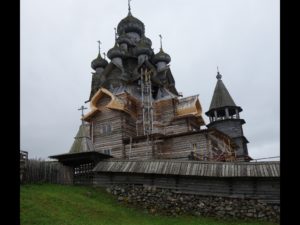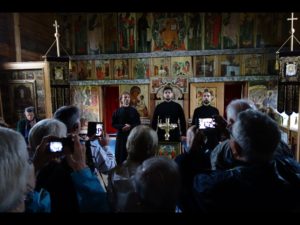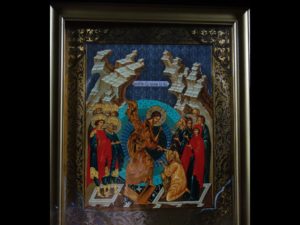The time on board is longer than it has been on other cruises we have taken. We cruise overnight and most of the day, then we get 3 or 4 hours in port. In the mean time, we see lots of woods. Logging seems to be the main industry of the area. One person in our tour group couldn’t understand why the river isn’t lined with summer homes. We’re here in the summer time, which is mostly rainy. In the winter, the river freeze is thick enough that they can land small airplanes on the ice.
Today’s stop is Kizhi. They moved several original Russian wooden churches and houses onto this island, putting them on display. Our guide was excellent. We didn’t receive a written summary of what we saw, so I won’t try to reproduce the Russian names for the structures.
This was an area with about 1,000 islands. People lived in small villages. Some villages had only one house. Each house provided shelter for an extended family of 20 or so persons. The dominant feature was the central church. It served as the area’s administrative center and graveyard. As in most communities, the main church had 3 buildings – a summer Church, a smaller but heated winter Church, and a bell tower. This Church was built in the 1714. There were no nails, because each nail was hand-made. 60 nails cost a cow. The Church as 22 cupolas because the parishioners lived on islands all around the area. Everybody wanted to see the front of the Church, so they built the Church “in the round”. The bell tower was built after 1900. By this time, cheap factory-made nails were available. The summer Church is being restored. We saw the interior of the winter Church. The buildings form an active Russian Orthodox Church. I did not realize than the Russian Orthodox used a wall of icons to separate the sanctuary from the alter. The winter Church has 4 tiers of icons. The summer Church is larger and has 7. People visit the alter only once or twice in their lifetimes (the stories I heard weren’t clear.) Baby boys visited the alter when they are baptized (but not girls). Couples are taken into the alter when they are married.
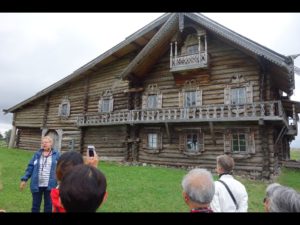
Rich person’s house – Danita’s grandmother had memories of living in a house similar to this, in Poland
We went inside one house. It housed 22 people, 10 cows, plus assorted chickens and a few horses. Residents were very self-reliant. They built their own houses, farm implements, boats, sleds, etc. There was one bed, which was made available to whichever woman had most recently given birth. Buildings were highly organized. A shelf ran around the interior of the house. Every family stored things in the same place. The shelf on one wall was reserved for sharp implements, a different one salt, one for hats and mittens, and one for pies. Shelves were high enough to keep the kids out. The cheese and butter making room was the clean room. (No kids with dirty feet allowed!) The detail picture shows where the barn section was joined to the house. In the summer, they moved cows to a nearby island. This was convenient because cows could graze where they want, but can’t wonder off into the woods or be attached by a bear. The only inconvenience was rowing out to the island twice a day to milk the cows and haul the pails of milk back to the house. The barn or grainery includes a hole for the cats.
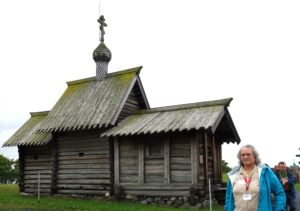 We saw a house for the less wealthy. Instead of a nice stove with a flue to the outside, they heated with an open fire. There was as circular hole in the roof, which could be opened or closed. There was lots of smoke when the fire was first lit. After 20 minutes, the smoke was mostly up by the ceiling and they opened the vent for a short while. After that, the fire was burning well and there was less smoke. They washed the walls down to clean the soot. They burned egg shells to make the ceiling shiny. The advantage of a “black house” is that it needed less wood to keep the house warm.
We saw a house for the less wealthy. Instead of a nice stove with a flue to the outside, they heated with an open fire. There was as circular hole in the roof, which could be opened or closed. There was lots of smoke when the fire was first lit. After 20 minutes, the smoke was mostly up by the ceiling and they opened the vent for a short while. After that, the fire was burning well and there was less smoke. They washed the walls down to clean the soot. They burned egg shells to make the ceiling shiny. The advantage of a “black house” is that it needed less wood to keep the house warm.
The last building we saw is Church reputed to have been built by Sty. Lazarus, the founder of the Murom Monastery. He died in 1391, making this the oldest wooden Church in Russia.

